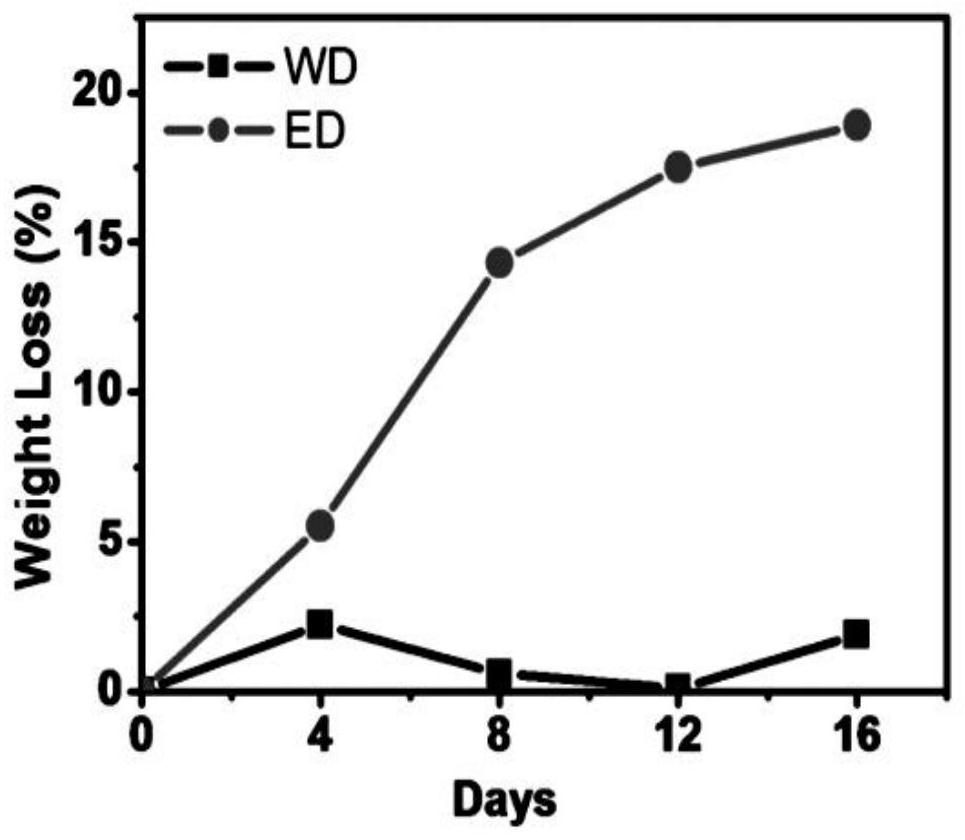Method for producing porous three-dimensional material by enzymatic degradation of PCL/PLLA polymer
A polymer and three-dimensional technology, applied in the biochemical treatment of enzymes/microorganisms, conjugated synthetic polymer artificial filaments, biochemical fiber treatment, etc., can solve the problems of less pore structure and no potential for ideal scaffolds, etc., and meet low requirements Effect
- Summary
- Abstract
- Description
- Claims
- Application Information
AI Technical Summary
Problems solved by technology
Method used
Image
Examples
Embodiment 1
[0024] A method for producing porous three-dimensional materials by enzymatically degrading PCL / PLLA polymers, comprising the following steps:
[0025] Step 1, dissolve PCL and PLLA with a mass ratio of 7:3 in a mixed solvent of dichloromethane and N,N-dimethylamide (the volume ratio of dichloromethane and N,N-dimethylamide is 3:1 ), obtain the PCL / PLLA solution of 10% by mass percentage;
[0026] Step 2, put the PCL / PLLA solution into a high-voltage electrospinning device for electrospinning. The technical parameters of the electrospinning are: spinning voltage 20kv, needle distance 20cm, drum speed 3000r / min, and the pump moves The speed is 50μm / s to obtain PCL / PLLA fiber membrane;
[0027] Step 3: Rinse the PCL / PLLA fiber membrane with alcohol and dry it thoroughly in a vacuum oven at a preset temperature of 40°C, and then place it in PBS buffer solution with esterase for degradation. The degradation time is 8 days. The concentration of the enzyme is 0.1mg / ml, the degrada...
Embodiment 2
[0029] A method for producing porous three-dimensional materials by enzymatically degrading PCL / PLLA polymers, comprising the following steps:
[0030] Step 1, dissolve PCL and PLLA with a mass ratio of 10:1 in a mixed solvent of dichloromethane and N,N-dimethylamide (the volume ratio of dichloromethane and N,N-dimethylamide is 4:1 ), obtain the PCL / PLLA solution of 5% by mass percent;
[0031] Step 2, put the PCL / PLLA solution into a high-voltage electrospinning device for electrospinning. The technical parameters of the electrospinning are: spinning voltage 10kv, needle distance 30cm, drum speed 2000r / min, and the pump moves The speed is 0.1μm / s, and the PCL / PLLA fiber membrane is obtained;
[0032] Step 3: Rinse the PCL / PLLA fiber membrane with alcohol and dry it thoroughly in a vacuum oven at a preset temperature of 40°C, and then place it in PBS buffer solution with esterase added for degradation. The concentration of esterase is 0.5mg / ml, the degradation temperature i...
Embodiment 3
[0034] A method for producing porous three-dimensional materials by enzymatically degrading PCL / PLLA polymers, comprising the following steps:
[0035]Step 1, dissolve PCL and PLLA with a mass ratio of 1:1 in a mixed solvent of dichloromethane and N,N-dimethylamide (the volume ratio of dichloromethane and N,N-dimethylamide is 5:1 ), obtain the PCL / PLLA solution of 15% by mass percent;
[0036] Step 2, put the PCL / PLLA solution into a high-voltage electrospinning device for electrospinning. The technical parameters of the electrospinning are: spinning voltage 15kv, needle distance 25cm, drum speed 1000r / min, and the pump moves The speed is 100 μm / s to obtain PCL / PLLA fiber membrane;
[0037] Step 3, rinse the PCL / PLLA fiber membrane with alcohol and place it in a vacuum oven at a preset temperature of 40°C to dry thoroughly, and then place it in PBS buffer solution with esterase added for degradation. The concentration of esterase is 0.01mg / ml, the degradation temperature wa...
PUM
| Property | Measurement | Unit |
|---|---|---|
| Membrane strength | aaaaa | aaaaa |
Abstract
Description
Claims
Application Information
 Login to View More
Login to View More - R&D
- Intellectual Property
- Life Sciences
- Materials
- Tech Scout
- Unparalleled Data Quality
- Higher Quality Content
- 60% Fewer Hallucinations
Browse by: Latest US Patents, China's latest patents, Technical Efficacy Thesaurus, Application Domain, Technology Topic, Popular Technical Reports.
© 2025 PatSnap. All rights reserved.Legal|Privacy policy|Modern Slavery Act Transparency Statement|Sitemap|About US| Contact US: help@patsnap.com



